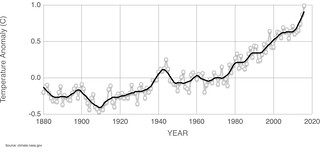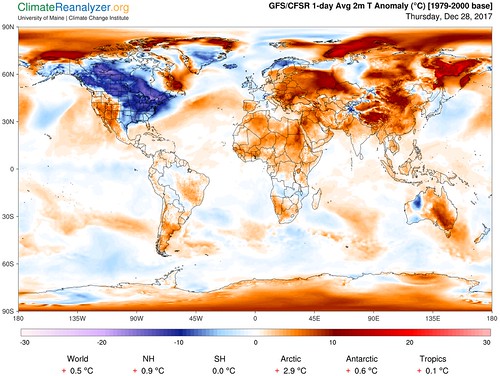Despite the incoming slug of cold air from the Arctic, this year has been hot. This is the third-warmest year to date. The globally-averaged temperature over land and ocean surfaces for this last November tied with November of 2016 as the fifth-highest November in the NOAA global temperature dataset record, dating back to 1880. NOAA updates the “State of the Global Climate” monthly. Here is a look at November.
It was the 395th consecutive month with temperatures at least nominally above the 20th century average.
Real. Heat.
That said, it is about to get crazy cold across the United States. Does that mean that “Global Warming” isn’t real? Let’s ask Dan. Dan Satterfield has been a meteorologist for almost four decades. He is a smart man. And because of that, has smart things to say.
Like this:
In 2017 (almost 2018), someone looking foolish on twitter is a daily occurrence. No one is immune. I’m probably guilty of it at some point, no doubt. But in this case – if I may make a supposition – Dan is referencing a tweet that is also a phone call that a lot of meteorologists receive here and there. It goes something like this:
“Hey Mr. Weather Man! I got six inches of global warming on my front lawn! What do you think about that, Mr. Weather Man? How can it be so warm, if it is snowing? Answer me that!”
That is nearly verbatim to a phone call I received almost 10 years ago now. I’ll never forget it. I know that happens to a lot of meteorologists, too. I even got a similar message after the snow on December 8th. A few facebook comments, too.
I’ve always taken it in stride. I’ll try to diffuse the sarcasm from the caller by trying my best explain that more crazy snow events are actually more likely with a warmer atmosphere. And I try to help the caller understand that while one area may be colder, another area may be hotter. Or many areas may be hotter. And hotter more often than it is cold. Like last year, where the entire globe had the warmest year on record.
Turns out that most of the world’s warmest years have happened during the last 35 years. According to NASA and NOAA, 16 of the 17 warmest years on record occurring since 2001. All of the top 10, since 1998.

Pause for the cause: What’s going on?
The biggest problem is fundamental chemistry is hurting us. Regular ‘ole Carbon is a really good heat trapper. Without anything else, just regular Carbon, can retain a fair amount of heat. Well, then Carbon starts to get into everything else. Carbon gets around. It can form bonds with a lot of stuff. It is in things like charcoal, gasoline, plastics, paper, and a whole bunch of other stuff, too.
The problem then becomes that we start to burn that stuff – whether for recreation or to get rid of it. And the Carbon changes from being in that stuff to being in the atmosphere. And Carbon then makes bonds with stuff in the air – like CO2. The more Carbon we put into the air, the warmer it gets. The warmer it gets, the more water vapor it can hold. The more water vapor it can hold, the more topsy-turvy our weather becomes.
Some folks say this is all part of a cycle. That is true. There is a natural cycle of heating and cooling. An Ice Age happens, then it retreats. The sun gets warmer, then cools down. Even the earths tilt wobbles ever so slightly creating times when it is warmer and cooler. These things have – historically – changed the climate over hundreds and thousands of years.

This speed of heating is happening in, roughly, 50 years. And can only be traced back to the industrial revolution.
The problem is that – again – Carbon is a heat trapper and can bond with a lot of stuff.
So we are exaggerating the warmer side of that cycle. And the changes we are seeing are happening much faster than can be explained by the long-term cycles mentioned above.
Coming back full-circle
The changing climate does change our weather, but it does so – generally – subtly. It tends to enhance the opportunity for certain events to occur, but can’t directly cause them to happen. I always think of it like a multiplier in video games. It makes the chances that something occurs (flooding, wildfires, massive hurricanes, deadly tornadoes) a bit more likely.
On the flip side, it can make other things less likely. Like flurries. When I was in Texas, I did some research on how light snow events were disappearing. I found that four of the 20 largest snow events in Amarillo history have hit in the past 12 years. One-quarter of all of the top 20 snow events have happened since 1986.
A warmer atmosphere does unique things to our weather. And sometimes it is tough to quantify.
It is often easier for news organizations to simply say, “Hurricane Maria strengthens to Cat 5, Climate Change to blame” but that isn’t exactly accurate. Truly, a warmer atmosphere, warms the oceans. That warmer water helps to feed hurricanes, allowing the hurricanes to strengthen easier. Allowing a better chance that it develops into a category 5. But an ease of something happening is not a guarantee of something happening.
But it a changing atmosphere does make the weather a bit wackier. Kinda stinks. I like the earth the way it was. I don’t want it to become something where the weather is even more violent. While I like job security, I don’t like it that much.
As the USA Today article linked to above suggests, winters are getting shorter and more potent. So, after the record heat of December subsides into a brief shot of cold air, it doesn’t mean that the atmosphere isn’t warming or changing. It just means it is doing what it should with a warmer atmosphere: being more chaotic. Sending record cold to the southern United States. And record heat to the rest of the globe.

What can we do?
Avoid using carbon-related things when possible. Amazingly, it is the little things that add up to be big things. For example, I bought a few aluminum water bottles to bring back a forth to work. I cut down on my plastic water bottle use by A LOT. I also walk places when I can instead of driving. And instead of using a gasoline powered leaf-blower, I just rake by hand (its also a good workout).
Putting less carbon up there keeps it from bonding with other stuff and warming up the atmosphere!

